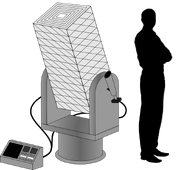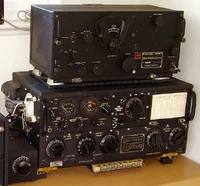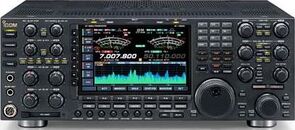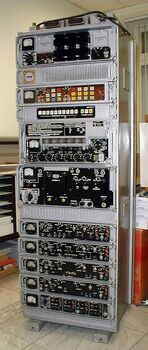
PGC Model 3402 Subspace radio. (A standard man is provided for size comparison.)
The subspace radio is the backbone of the communications network that holds the Frontier together as it provides the means to communicate across interstellar distances in a reasonable amount of time.
Subspace Radio Basics[]
Compared to videocom radios, subspace radios are expensive and power hungry. The radio itself costs 20,000 Cr. It requires a Type I Parabattery to run (or needs to be attached to a larger power source) and uses 100 SEU to send a single message. And with a mass of 100 kg, it is too bulky to be carried and require a relatively fixed installations either on a planetary surface, station, or ship. It could be mounted on the back of a ground vehicle, but beyond a few military applications, there isn't much point, as the increased complexity of operation would counteract any advantage the mobility gained you.
The transmission speed of a subspace radio is fast. The messages cover one light year in a single hour. That's a little more than 8,700 times faster than the speed of light or 8,700 times faster than a videocom radio. So that means that sending a message from one end of a planetary system to the other is nearly instantaneous. A message from Earth to Mars that would take about 21 minutes with a videocom radio would only take 0.15 seconds; a slight delay, but less than the videocom signal between the Earth and the Moon (1.25 seconds). Messages between stars would take hours instead of days and interstellar communications would be feasible.

Obsolete subspace radio transmitter
Unlike a videocom radio, subspace radios can only be used in a beamed transmission mode. They cannot broadcast omni-directionally. The same is true for the receivers. Both radios have to be pointed at each other for the message to be transmitted. In addition, the alignment of the transmitter has to be fairly exact in order to get the message to the correct destination. This means that it can't be used easily from a moving ground vehicle or a maneuvering starship (i.e. in combat, basic accelerations are okay) as the rapid changes in attitude of the transmitter would throw it out of alignment and the signal would not go to the correct place.
Another difference between the subspace radio and the videocom radio is that while the videocom radio can transmit continuously, the subspace radio sends its signals in small bursts of information, called packets. It takes a finite amount of time to compose the "packet" to be sent. So while the time delay within a system is small, there is an additional overhead that adds a bit more delay to the transmission and receiving process that makes two-way conversation a difficult.
Physical Design[]

Modern high-gain subspace radio antenna
The transmitter/receiver "antenna" of a subspace radio is a large lattice of electrical wiring and transducer nodes. Roughly a meter and a half in length and half a meter square, the antenna has multiple concentric box lattices inside one another. The details of the spacing and positioning of the lattice and transducer nodes are what allow the radio to create the tachyon beams that allow the faster-than-light communication.
The antenna is typically mounted on an alt-azimuth mount and has a small optical telescope with a digital camera mounted co-axially with the antenna to allow for alignment. More advanced models have additional alignment axes that can be set and locked into position based on the latitude of the location to allow for easier/permanent alignment of the subspace radio at a fixed installation.
The parabattery is typically installed inside the base of the mount and the radio is controlled via a separate control panel that is connected to the radio via cabling allowing it to be moved and positioned as needed for convenience of operation.
Subspace Radio Operations[]
Subspace radios works by sending coded beams of tachyons. Tachyons are theoretical particles that, like normal particles, can never travel at the speed of light. However, unlike normal particles, they cannot travel slower that the speed of light. In fact they travel faster the less energy that they have. They represent a solution to the special relativity equations for particles with imaginary mass. It is these properties that allow them to be used for faster than light communications.
As was said before, subspace transmissions are beamed. This means that the transmitter must be pointed at the destination system. But for subspace transmissions, it also means that the receiver must be pointed at the transmitting system as well. If either of the two radios is out of alignment, then the message will not make it to its destination.
While the transmissions are beamed, the beam does spread out over interstellar distances, covering the entire system at the destination end. Thus any subspace radio pointed back at the transmitting system when the message arrives could potentially receive the transmitted messages. Because the transmitted messages can be received on any subspace radio in the receiving system they are typically both coded for the recipient and encrypted for privacy.
Message Coding[]
| Sidebar Example: Obar Enterprises, has offices on Pale and Triad and facilities on New Pale and Rupert's Hole (among others). All four facilities are connected via subspace radio (with a 5 hour delay between the Truane's Star and Cassidine systems) and are keyed to only listen to messages coded with OE registered transmission codes and general UPF broadcasts. The receiver in Triad can detect any signal originating in the Truane Star system whether it is from the Pale office, the New Pale facilites, or one of OE's ships in that system. The same is true for the Rupert's Hole facility. However, the Rupert's Hole facility doesn't care about general business transmissions so it only listens for the messages coded directly to it. The Triad office, on the other hand, is set to receive any OE coded transmission whether directed specifically to the Triad office or to the Rupert's Hole facility or to any of the OE ships currently in the Cassidine system. |
Message coding is just a bit of identifying information at the beginning of the message that signifies who the message is from and who it is intended for. It consists of an ID string that identifies the transmitting radio, another user supplied ID that identifies the

Encoding module
person or organization making the transmission and optionally a third ID that identifies the intended recipient. If the third ID is omitted, the transmission is considered uncoded and is generally intended to be a public message. Types of messages that would be sent uncoded are SOS signals, general UPF broadcasts, and any other type of message that the transmitter doesn't care who receives it.
On the receiving end, the subspace radio can be configured to only listen for messages that arrive from specific transmitting radios, specific transmitter IDs, or which are intended for specific recipients. In setting these parameters, lists and wild cards are often used to listen to a range of possible ID values. In this case, the radio will listen for messages that match the receive settings and only record the messages that match. It is also possible to listen for messages being sent to anyone.
The central Subspace Registry, located on Triad, holds the records of what IDs are registered to what individuals and organizations. While not every ID used has been (or needs to be) registered, most organizations will register their IDs so that they can lay claim to those identifiers (much like webpage domain registration today).
Message Encryption[]
Since anyone with a radio pointed in the right direction can receive and record a subspace message, most messages, in addition to being coded for their recipient, are also encrypted to prevent unauthorized reading of the message. The exception to this is typically SOS calls and general broadcasts from the UPF intended for all Frontier citizens, whether they be alerts or general messages.
Most messages, however, are encrypted. The encryption schemes can vary but even the very basic encryption schemes built into the subspace radios are extremely difficult to crack without the proper encryption keys that the message was generated from. If the receiving system has those keys, the message decryption is straightforward. For radios that record the message without the correct decryption keys, the message is effectively just a bunch of noise useful only as a random number generator.
Subspace Frequencies[]

Modern subspace radio transmitter showing frequency spread
There are multiple "subspace frequencies" that the messages can be sent on. Any given subspace radio can only transmit or receive on one "frequency" at a time but multiple radios in the same system can send/receive messages simultaneously on different "frequencies" without interfering. A radio that is not actively transmitting or receiving a message can monitor all the frequencies for incoming messages that are coded to it. When one is received, they lock onto that frequency and receive the message. So if two messages from the same system (i.e. the direction it is pointed) come in at the same time, it will only hear one and miss the other.
This is another area where the referee can tweak the operation of subspace radios to fit the feel of his campaign. Maybe there is only one frequency and so if two transmitters operate at the same time, they scramble each other's signals. Or maybe there are only a few frequencies so that the chance of overlap is smaller but the total bandwidth of subspace communications is limited by the number of frequencies. In these situations, control of the radios or at least regulation of transmissions becomes more important.
Another possible modification is to limit the number of frequencies the radio can listen on. Maybe the radios can't listen on all frequencies when not actively recording a message but are limited to a small range or even a single frequency like today's traditional radios. Thus if you're not listening to the correct frequencies, you might miss the message even if it was being sent to you and you were listening in the right direction at the right time.
Operating a Subspace Radio[]
Using a subspace radio is straightforward, if somewhat difficult. Most of the difficulty lies in getting it aligned with the destination system. For fixed installations of a subspace radio, all of the hard work has been done when the installation was set up. In those cases, the positions and angles to each of the systems in the Frontier that the subspace radio are calculated in advance and then it is just a matter of matching the time against the destination and the computer moving the dish to point in the right direction.

High-power subspace radio transmitter
Of course this brings up another point. Since the subspace beams are directional, you can only broadcast to receivers that are above your horizon. If the intended receiving system is below your horizon, then you will have to wait until it rises before you can send a message. While no one has ever computed that detailed of astronomical data for the systems of the Frontier, it can still be used as a plot hook. The PC's have finally gotten the parts to repair the subspace radio and send off their SOS message. But Triad is below the horizon and won't rise for another three hours. Can they hold out against the hordes of angry natives long enough to send the message? Or will they have to retreat from the complex before they get the chance?
For non-fixed subspace radios, either ones on ships, ones that have been carried as cargo and then set up at the PC's camp or base, or the installation of a new radio at a fixed location, the procedure is a little more complicated. In that case, the radio has to be aligned in order to make the transmission. This requires a bit of work and a little bit of knowledge. The exact time and difficulty depends on the skill set the character has, and the distance to the target.
Characters with Astronomical Skills[]
Subspace radio alignment is easiest for characters with some sort of astronomical skills. From the standard AD/KH rules, this would be someone with the Astrogation skill from Knight Hawks. For the Zebulon's Guide skills, this would be someone with the Communication Equipment: Operate skill as that skill specifically includes the use of subspace radios. (Interestingly, there is no Astronomy skill in Zeb's Guide or an Astrogation skill for that matter.) If using some other skill system, like "A Skilled Frontier" from issue 9 of the Star Frontiersman Magazine, use whatever skill grants astronomical knowledge.
For these characters, subspace radio alignment takes (1d10-skill level + distance in light years) x 10 minutes or a minimum of 10 minutes whichever is more. This assumes that the alignment is done at night. If done during the day the die roll changes from 1d10 to 2d10. In addition, the character has to make a skill check to make sure that the alignment is done properly. The success chance is 100% + 10% x skill level - 5% x distance to the target in light years. A roll of 96-100 always fails even if the chance of success is 100% or more.
If the characters are in, or trying to align on a remote system, a failed alignment can only be detected by spending another alignment period and making another skill check or sending a message and waiting for a reply. If none is received after the expected amount of time, then the alignment may be off. If the characters are in a populated system and are aligning on another populated system, a misalignment can be detected in just 1d10 minutes as the system would not be registering any incoming signals of any sort.
Characters without Astronomical Skills[]
For characters without any relevant astronomical skills, the alignment is a little bit more difficult as they lack the detailed astronomical knowledge to simplify the process. It is assumed that most adventures are at least passingly familiar with the skies of the Frontier and can identify the major populated systems (moving around the Frontier doesn't change the positions of most of the stars in the sky, just the ones actually in the Frontier). Thus given time they can get a subspace radio antenna pointed at the right star.
For these characters, the alignment time takes (2d10 + distance in light years) x 10 minutes and must be done at night when they can see the target above the horizon. The success chance in this case is LOG – 5% x distance to target in light years. The referee may assign bonuses depending on the characters background, experiences, or skills if he so desires.
Economics[]
In all the discussion so far, we've ignored how much data you can send via subspace radio. The Alpha Dawn rules don't define the size of the "message" that costs 100 SEU to transmit. This is left up the referee. For the discussion of this article, let's say that a message consists of no more than 10 minutes of audio, 1 minute of video plus audio, or some fixed amount of data. That's what you can send with that 100 SEU of power. However, there is nothing to stop you from sending multiple bursts if you have the power and need to transmit more data. You can vary the actual amount per burst depending on what you want in your campaign. More data per message makes interstellar communication cheaper and more common while less data per burst makes is more expensive and rarer. Personally, I like to keep costs high in my Frontier so I say a burst is 1 minute of audio or 6 seconds of video. (A factor of 10 more expensive to send messages).
At the default rates I suggested, you could send small video clips or a reasonable amount of audio or data in a single transmission. The transmission costs 500 credits (the cost of 100 SEU) but your message will arrive in a few hours instead of the days it takes to make an interstellar jump via ship.
What if you are StarPlay and wanted to broadcast the Galaxy Cup competition (whatever that may be) "live" via subspace radio? What would that cost StarPlay? Assuming the broadcast was 3 hours long and you used full video, that would be 180 transmissions at 100 SEU apiece or 18000 SEU to transmit which costs 90,000 cr. And that is per receiving system. Since the broadcast needs to be transmitted to each receiving system independently, that cost is multiplied by the number of receivers. Ignoring the Rim and Zebulon, there are 17 systems in the Frontier. That means you have to make 16 different transmissions from 16 different subspace radios. You're looking at 320,000 cr for the radios, plus 1,440,000 cr for the transmission power. And that's just to get the signal to the subspace radios in each destination system. You then have to broadcast it out, via videocom to the general population, once it has arrived at the destination receiver but we're discussing only the subspace costs here.
So this is definitely a big business item, you're only going to do it for major events since you're talking about nearly two million credits to broadcast a 3 hour event to the Frontier. It can be done, it is just expensive.
Other Considerations[]
Listening Posts[]

Small subspace listening post
The nature of subspace communications practically dictates large listening posts. These posts would contain dozens to hundreds of subspace receivers pointed at the various inhabited systems of the Frontier. Multiple receivers would be pointed at each system to monitor the transmissions and be capable of receiving multiple messages at the same time.
These listening posts could have a variety of uses ranging from StarPlay's broadcast network hubs which are used to receive entertainment news from around the Frontier, to the central hub of a multi-system corporation used to monitor and receive reports on its operations in various systems, to UPF run intelligence gathering stations.
Military Uses[]
The FTL communications capabilities provided by the subspace radio means that information can be transmitted relatively quickly between the field and central command. It also means that orders can be transmitted back to the field quickly as well. This has both good and bad consequences.
On the plus side, intelligence can be quickly relayed to a central location or locations for analysis by more people with a greater breadth of information, making trends, patterns, and correlations more likely to be discovered quickly. On the down side, there will always be a tendency of the higher ups to want to try to micromanage the field operations and the relatively short time scales for message transmission may lead to policies that require field commanders to "check in" regularly or before major operations. The delays can be large enough that the round trip times may cost opportunities and lives.
Another aspect is that there will probably be dedicated communication ships that are part of most fleet movements or at least part of the major Task Forces. These ships provide the subspace link between the fleet and central command. During major battles they probably hang back and out of the way. The fleet ships communicate with the communications ship via videocom radio and the communication ship passes information on to central command via subspace transmissions.
(Cited from Subspace Radios, by Tom Stephens, from Frontier Explorer issue #4)